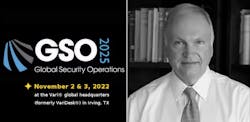Editor’s note: This is the sixth in a series of interviews with the session leaders of the upcoming GSO 2025 event being held Nov. 2-3, 2022 at VariSpace Las Colinas, in Irving, Texas. Registration is open now.
The following is an interview of Park Dietz, M.D., MPH, Ph.D, and founder of Threat Assessment Group, Inc., by security consultant Lynn Mattice.
Mattice: What do you view as the root cause of the dramatic increase in violence in America?
Dr. Dietz: While it’s better to look at the causes of specific types of violence — not all of which spring from identical sources — I’d argue that the four root causes of most types of violence are these:
- Erosion of the institutions of social control. For centuries, humans were kept in line to some extent by religion, morality, family, education, law enforcement, and the law. As these have been eroded, they’ve been increasingly replaced with the influences of the mass media, social media, the entertainment industry, the music industry, and those advocacy groups that make the most noise. These growing influences are too often incendiary or malicious.
- Dissolution of the social contract. To the extent that social forces turn groups and tribes against one another, the ties that bind are weakened and sources of conflict multiply. Identity politics is one of the obvious examples of this influence.
- The disappearance of discipline from families, schools, and most civilian organizations. Earlier generations were disciplined firmly at home and school, knew what behavior was expected of them, and knew their livelihood depended on civility at work. This is no longer true.
- Hopelessness. In at least some cultures, poverty drives hopelessness, and now inflation is impoverishing millions more Americans. For young males, hopelessness is pandemic. They are told daily that there won’t be jobs for them, that they can’t expect to enjoy the standard of living of their parents, that they won’t be able to afford a family, that the draft might be reinstated, that famine is on the horizon, and that climate change will soon end the world.
To see these root causes in action, one need look no further than the riots since 2020, the attacks on abortion providers and pro-life groups, or the routine shootings in many major cities.
Of course, for specific types of violence, there are other causes of the increase, such as pandemic lockdowns increasing substance abuse and other mental disorders and increasing intimate partner violence by keeping victims in the same space as their abusers.
Mattice: Why have mass shootings escalated so significantly? Churches, schools, retail establishments, hotels, restaurants have all experienced mass shooting. Nowhere seems to be a sanctuary from violence these days. What has changed in society?
Dr. Dietz: “Mass shootings” is an artificial category formulated to focus attention on firearms instead of root causes. What is true of mass shootings is also true of multi-victim attacks using edged weapons, vehicles, or explosives. In addition to the root causes identified above, at least one additional factor is more specific to multi-victim armed attacks. As I began to tell the media often starting around 1993, mass murder is a form of suicide propagated by the mass media. Originally, I referred to it as “the CNN effect” because CNN was the only 24-hour news channel on television, but there are now many other legacy media and social media contributing to the overall effect, which is to market mass murder and attempted mass murder as the fashionable exit plan for every suicidal, grievance-laden male in the target audience. While most of the early cases involved suicidal, paranoid males, ever since the Columbine High School incident, increasing proportions of the killers have been angry or aggrieved rather than paranoid, and increasing proportions have been young males.
Newspapers have long recognized that their coverage of suicide cases has the potential to cause copycat cases, and ethical journalists take care to avoid this effect when reporting what they recognize as suicide. I’ve propounded guidelines to reduce this effect—such as not naming the killer in the early coverage, limiting intense coverage to the local market, and more — but even when an individual outlet has heeded such advice, they’ve soon reverted to the worst kind of sensational coverage, particularly when pushing a gun control agenda.
Although not specific to multi-victim attacks, another factor is the rising rates of some mental disorders. Although the best evidence lags by a few years, it appears that rates of substance abuse, depressive disorders, anxiety disorders, and autism spectrum disorders continue to rise. Each of these is involved in some multi-victim attacks and much larger numbers of more common violent crimes, including homicide, assault, robbery, and rape.
Not long ago, it was only the paranoid who believed others were conspiring to hold them down. But now, one or more generations have been imbued with grievance curricula designed to make them angry and to propel them to action. Whether that action is becoming an informed voter, a protesting activist, or a mass murderer depends on a host of factors, but nobody should be surprised if a few hundred a year take the colorful, lazy route with the expectation of becoming famous. Some seek notoriety, some seek to spark or advance a movement, some seek both, and all know they are risking death or imprisonment.
The most extraordinary thing about multi-victim attacks is that the offenders universally throw off signals that much is amiss, sometimes for years before the attack, and many get away with escalating levels of misconduct without consequence until the ultimate attack. Family and societal systems are woefully inadequate to generate reports of these signals, to investigate these reports, and to manage risks. Corporations, in contrast, can do a masterful job of spotting and managing these and other risks among employees, and many now do.
Mattice: What steps should an enterprise take to reduce the probability of violence occurring on their property.
Dr. Dietz:
- Ensure that each location has appropriate access controls.
- Issue trespass warnings to every outsider who misbehaves.
- Close locations with unacceptable rates of violent or other crimes.
- Screen new hires appropriately and make thoughtful, good judgments toward the end of a probationary period.
- Manage employees properly, using progressive discipline.
- Institute an early warning system that makes it easy for employees to report every act of incivility, bullying, intimidation, and harassment so that bad actors are corrected or removed long before they’ve escalated to the point of threats, stalking, or assaults.
Mattice: What kind of training should people get to understand how they should react?
Dr. Dietz: While a few of our clients report success with live active shooter drills and training, we do not recommend going to this expense unless all of the more important security programs are already in place and they can deliver it in a manner that avoids frightening or traumatizing employees, some of whom have already suffered undisclosed trauma. The lessons of most “Run, Hide, Fight” training are frightening and potentially traumatizing, so we developed versions that avoid any graphic violence or anything traumatizing. Even with our gentle training, we recommend it be made available but optional so that no one is required to do something they can’t handle emotionally.
You will do far more to improve the safety and welfare of your employees — and your bottom line, too — if you instead require intense training for an interdisciplinary team of those who manage misconduct, training for managers on how to manage troubled employees and troubling situations, and training for employees on what, how, and why to report their observations of behavior that makes them uncomfortable. We’ve been doing this for 35 years, and the technology to reach all of these audiences is improving rapidly.
Park Dietz, MD, MPH, PhD, is founder and president of both the world’s first company devoted to workplace violence prevention—Threat Assessment Group, Inc.—and the interdisciplinary expert witness firm—Park Dietz & Associates, Inc.—based in Newport Beach, CA. Educated at Cornell, Johns Hopkins, and the University of Pennsylvania, he served as Assistant Professor of Psychiatry at Harvard Medical School, and as Professor of Law and Professor of Behavioral Medicine and Psychiatry at the University of Virginia, and currently serves as Clinical Professor of Psychiatry at the UCLA David Geffen School of Medicine. For decades, he was a psychiatric consultant to the FBI’s Behavioral Science and Behavioral Analysis Units, working closely with the original cadre of FBI profilers.
Lynn Mattice, is founder and Program Chair of the Executive Summit Series™ a premier forum that brings together the most senior risk, security and resilience executives representing both the private and public sectors during DSAC Week in Washington D.C. The Summit is “Where leaders share their vision of the future and tackle the front of mind issues they face today. Mattice has nearly 50 years’ experience as a leading voice in the security industry that included serving as CSO for three major global corporations and one mid-cap enterprise; establishing a highly successful management consulting firm; and serving on key security industry and government boards and taskforces. Mattice also founded and leads the National Economic Security Alliance, a nonpartisan IRS designated 501(c)(3) nonprofit focused at safeguarding America’s Economic Security, its number one National Security Issue today and for the foreseeable future.

